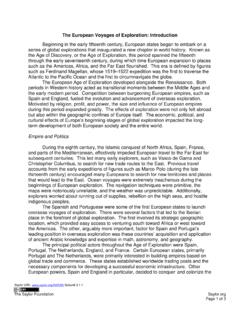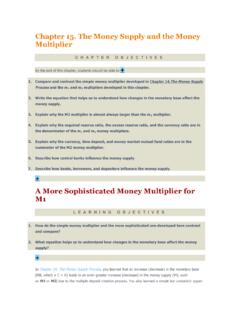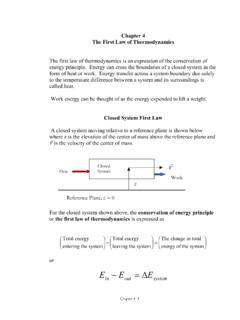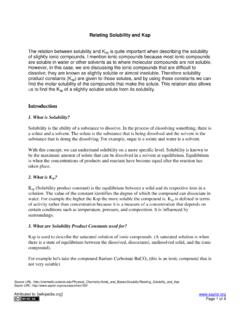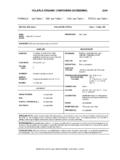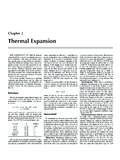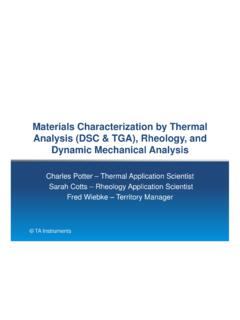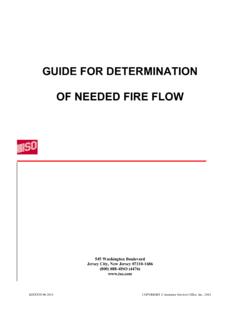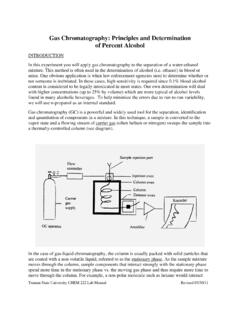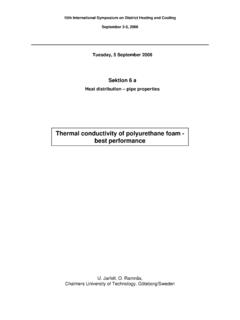Transcription of Thermal conductivity - Saylor Academy
1 Thermal conductivity1 Thermal conductivityIn physics, Thermal conductivity , , is the property of a material's ability to conduct heat. It appears primarily inFourier's Law for heat conduction. Thermal conductivity is measured in watts per kelvin-meter (W K 1 m 1, (K m) or in IP units (Btu hr 1 ft 1 F 1, Btu/(hr ft F). Multiplied by a temperature difference (in kelvins, K)and an area (in square meters, m2), and divided by a thickness (in meters, m), the Thermal conductivity predicts therate of energy loss (in watts, W) through a piece of material. In the window building industry " Thermal conductivity "is expressed as the U-Factor [1], which measures the rate of heat transfer and tells you how well the windowinsulates. U-factor values are generally recorded in IP units (Btu/(hr ft F)) and usually range from to Thelower the U-factor, the better the window reciprocal of Thermal conductivity is Thermal are a number of ways to measure Thermal conductivity .))
2 Each of these is suitable for a limited range ofmaterials, depending on the Thermal properties and the medium temperature. There is a distinction betweensteady-state and transient general, steady-state techniques are useful when the temperature of the material does not change with time. Thismakes the signal analysis straightforward (steady state implies constant signals). The disadvantage is that awell-engineered experimental setup is usually needed. The Divided Bar (various types) is the most common deviceused for consolidated rock transient techniques perform a measurement during the process of heating up. Their advantage is quickermeasurements. Transient methods are usually carried out by needle IEEE Standard 442-1981, "IEEE guide for soil Thermal resistivity measurements", ISBN 0-7381-0794-8. See alsosoil Thermal properties. [2] [3] IEEE Standard 98-2002, "Standard for the Preparation of Test Procedures for the Thermal Evaluation of SolidElectrical Insulating Materials", ISBN 0-7381-3277-2 [4] [5] ASTM Standard D5334-08, "Standard Test Method for Determination of Thermal conductivity of Soil and SoftRock by Thermal Needle Probe Procedure" [6] ASTM Standard D5470-06, "Standard Test Method for Thermal Transmission Properties of ThermallyConductive Electrical Insulation Materials" [7] ASTM Standard E1225-04, "Standard Test Method for Thermal conductivity of Solids by Means of theGuarded-Comparative-Longitudinal Heat Flow Technique" [8] ASTM Standard D5930-01, "Standard Test Method for Thermal conductivity of Plastics by Means of a TransientLine-Source Technique" [9] ASTM Standard D2717-95, "Standard Test Method for Thermal conductivity of Liquids" [10] ISO 22007-2:2008 "Plastics -- Determination of Thermal conductivity and Thermal diffusivity -- Part 2.
3 Transientplane heat source (hot disc) method" [11] Note: What is called the k-value of construction materials ( window glass) in the , is called -value inEurope. What is called U-value (= the inverse of R-value) in the , used to be called k-value in Europe, but isnow also called U-value in conductivity2 DefinitionsThe reciprocal of Thermal conductivity is Thermal resistivity, usually measured in kelvin-meters per watt (K m W 1).When dealing with a known amount of material, its Thermal conductance and the reciprocal property, thermalresistance, can be described. Unfortunately, there are differing definitions for these general scientific use, Thermal conductance is the quantity of heat that passes in unit time through a plate ofparticular area and thickness when its opposite faces differ in temperature by one kelvin. For a plate of thermalconductivity k, area A and thickness L this is kA/L, measured in W K 1 (equivalent to: W/ C).
4 Thermal conductivityand conductance are analogous to electrical conductivity (A m 1 V 1) and electrical conductance (A V 1).There is also a measure known as heat transfer coefficient: the quantity of heat that passes in unit time through unitarea of a plate of particular thickness when its opposite faces differ in temperature by one kelvin. The reciprocal isthermal insulance. In summary: Thermal conductance = kA/L, measured in W K 1 Thermal resistance = L/(kA), measured in K W 1 (equivalent to: C/W) heat transfer coefficient = k/L, measured in W K 1 m 2 Thermal insulance = L/k, measured in K m W heat transfer coefficient is also known as Thermal admittanceResistanceWhen Thermal resistances occur in series, they are additive. So when heat flows through two components each with aresistance of 1 C/W, the total resistance is 2 common engineering design problem involves the selection of an appropriate sized heat sink for a given heatsource.
5 Working in units of Thermal resistance greatly simplifies the design calculation. The following formula canbe used to estimate the performance:where: Rhs is the maximum Thermal resistance of the heat sink to ambient, in C/W is the temperature difference (temperature drop), in C Pth is the Thermal power (heat flow), in watts Rs is the Thermal resistance of the heat source, in C/WFor example, if a component produces 100 W of heat, and has a Thermal resistance of C/W, what is themaximum Thermal resistance of the heat sink? Suppose the maximum temperature is 125 C, and the ambienttemperature is 25 C; then the is 100 C. The heat sink's Thermal resistance to ambient must then be C/Wor conductivity3 TransmittanceA third term, Thermal transmittance, incorporates the Thermal conductance of a structure along with heat transfer dueto convection and radiation. It is measured in the same units as Thermal conductance and is sometimes known as thecomposite Thermal conductance.
6 The term U-value is another summary, for a plate of Thermal conductivity k (the k value [12] ), area A and thickness t: Thermal conductance = k/t, measured in W K 1 m 2; Thermal resistance (R-value) = t/k, measured in K m W 1; Thermal transmittance (U-value) = 1/( (t/k)) + convection + radiation, measured in W K 1 m 2. K-value refers in Europe to the total insulation value of a building. K-value is obtained by multiplying the formfactor of the building (= the total inward surface of the outward walls of the building divided by the total volumeof the building) with the average U-value of the outward walls of the building. K value is therefore expressed as(m2 m 3) (W K 1 m 2) = W K 1 m 3. A house with a volume of 400 m and a K-value of (the new Europeannorm. It is commonly referred to as K45) will therefore theoretically require 180 W to maintain its interiortemperature 1 K above exterior temperature. So, to maintain the house at 20 C when it is freezing outside (0 C),3600 W of continuous heating is metals, Thermal conductivity approximately tracks electrical conductivity according to the Wiedemann-Franz law,as freely moving valence electrons transfer not only electric current but also heat energy.
7 However, the generalcorrelation between electrical and Thermal conductance does not hold for other materials, due to the increasedimportance of phonon carriers for heat in non-metals. As shown in the table below, highly electrically conductivesilver is less thermally conductive than diamond, which is an electrical conductivity depends on many properties of a material, notably its structure and temperature. For instance,pure crystalline substances exhibit very different Thermal conductivities along different crystal axes, due todifferences in phonon coupling along a given crystal axis. Sapphire is a notable example of variable thermalconductivity based on orientation and temperature, with 35 W/(m K) along the c-axis and 32 W/(m K) along thea-axis.[13]Air and other gases are generally good insulators, in the absence of convection. Therefore, many insulating materialsfunction simply by having a large number of gas-filled pockets which prevent large-scale convection.
8 Examples ofthese include expanded and extruded polystyrene (popularly referred to as "styrofoam") and silica aerogel. Natural,biological insulators such as fur and feathers achieve similar effects by dramatically inhibiting convection of air orwater near an animal's is used for its low Thermal conductivityon exhaust systems to prevent heat from reachingsensitive componentsLight gases, such as hydrogen and helium typically have high thermalconductivity. Dense gases such as xenon and dichlorodifluoromethanehave low Thermal conductivity . An exception, sulfur hexafluoride, adense gas, has a relatively high Thermal conductivity due to its highheat capacity. Argon, a gas denser than air, is often used in insulatedglazing (double paned windows) to improve their conductivity is important in building insulation and relatedfields. However, materials used in such trades are rarely subjected toThermal conductivity4chemical purity standards.
9 Several construction materials' k values are listed below. These should be consideredapproximate due to the uncertainties related to material following table is meant as a small sample of data to illustrate the Thermal conductivity of various types ofsubstances. For more complete listings of measured k-values, see the valuesExperimental values of Thermal is a list of approximate values ofthermal conductivity , k, for somecommon materials. Please consult thelist of Thermal conductivities for moreaccurate values, references anddetailed conductivityW/(m K)Silica - - Fill Fibre and - [14]Mineral - , (silica-filled) (unfilled) (liquid) - 3 Thermal epoxy1 - , ~ (pure)120 180 (alloys)Gold318 Copper401 Silver429 Diamond900 - 2320 Graphene(4840 440) - (5300 480)Physical originsHeat flux is exceedingly difficult to control and isolate in a laboratory setting.
10 Thus at the atomic level, there are nosimple, correct expressions for Thermal conductivity . Atomically, the Thermal conductivity of a system is determinedby how atoms composing the system interact. There are two different approaches for calculating the thermalconductivity of a system. The first approach employs the Green-Kubo relations. Although this employs analytic expressions which inprinciple can be solved, in order to calculate the Thermal conductivity of a dense fluid or solid using this relationrequires the use of molecular dynamics computer simulation [15]. The second approach is based upon the relaxation time approach. Due to the anharmonicity within the crystalpotential, the phonons in the system are known to scatter. There are three main mechanisms for scattering: Boundary scattering, a phonon hitting the boundary of a system; Mass defect scattering, a phonon hitting an impurity within the system and scattering; Phonon-phonon scattering, a phonon breaking into two lower energy phonons or a phonon colliding withanother phonon and merging into one higher energy wavesHeat transport in both glassy and crystalline dielectric solids occurs through elastic vibrations of the lattice(phonons).


